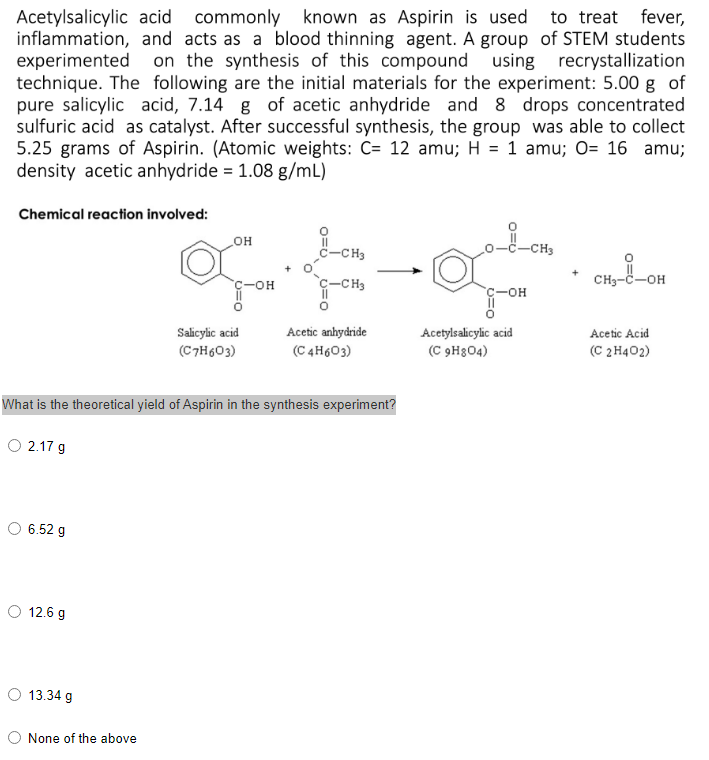Acetylsalicylic acid commonly known as Aspirin is used to treat fever, inflammation, and acts as a blood thinning agent. A group of STEM students experimented on the synthesis of this compound technique. The following are the initial materials for the experiment: 5.00 g of pure salicylic acid, 7.14 g of acetic anhydride and 8 drops concentrated sulfuric acid as catalyst. After successful synthesis, the group was able to collect 5.25 grams of Aspirin. (Atomic weights: C= 12 amu; H = 1 amu; O= 16 amu; density acetic anhydride = 1.08 g/mL) using recrystallization Chemical reaction involved: -CH3 -CH3 CH3-C-OH c-OH CH3 E-OH Acetylsaicylic acid (C 9H3O4) Acetic anhydride Salicylic acid (C7H6O3) Acetic Acid (C 4H603) (C 2 H402) Vhat is the theoretical yield of Aspirin in the synthesis experiment? O 2.17 g O 6.52 g O 12.6 g O 13.34 g O None of the above
Acetylsalicylic acid commonly known as Aspirin is used to treat fever, inflammation, and acts as a blood thinning agent. A group of STEM students experimented on the synthesis of this compound technique. The following are the initial materials for the experiment: 5.00 g of pure salicylic acid, 7.14 g of acetic anhydride and 8 drops concentrated sulfuric acid as catalyst. After successful synthesis, the group was able to collect 5.25 grams of Aspirin. (Atomic weights: C= 12 amu; H = 1 amu; O= 16 amu; density acetic anhydride = 1.08 g/mL) using recrystallization Chemical reaction involved: -CH3 -CH3 CH3-C-OH c-OH CH3 E-OH Acetylsaicylic acid (C 9H3O4) Acetic anhydride Salicylic acid (C7H6O3) Acetic Acid (C 4H603) (C 2 H402) Vhat is the theoretical yield of Aspirin in the synthesis experiment? O 2.17 g O 6.52 g O 12.6 g O 13.34 g O None of the above
Chapter13: Isolation Of Eugenol From Clov
Section: Chapter Questions
Problem 9Q
Related questions
Question
What is the theoretical yield of Aspirin in the synthesis experiment?

Transcribed Image Text:Acetylsalicylic acid commonly known as Aspirin is used to treat fever,
inflammation, and acts as a blood thinning agent. A group of STEM students
experimented on the synthesis of this compound using recrystallization
technique. The following are the initial materials for the experiment: 5.00 g of
pure salicylic acid, 7.14 g of acetic anhydride and 8 drops concentrated
sulfuric acid as catalyst. After successful synthesis, the group was able to collect
5.25 grams of Aspirin. (Atomic weights: C= 12 amu; H = 1 amu; O= 16 amu;
density acetic anhydride = 1.08 g/mL)
Chemical reaction involved:
II
C-CH3
-CH3
c-CH3
CH3-C-OH
c-OH
c-OH
Salicylic acid
(C7H603)
Acetic anhydride
(C 4H603)
Acetylsalicylic acid
(C 9H3O4)
Acetic Acid
(C 2 H402)
What is the theoretical yield of Aspirin in the synthesis experiment?
O 2.17 g
O 6.52 g
O 12.6 g
O 13.34 g
O None of the above
Expert Solution
This question has been solved!
Explore an expertly crafted, step-by-step solution for a thorough understanding of key concepts.
Step by step
Solved in 2 steps

Knowledge Booster
Learn more about
Need a deep-dive on the concept behind this application? Look no further. Learn more about this topic, chemistry and related others by exploring similar questions and additional content below.Recommended textbooks for you

EBK A SMALL SCALE APPROACH TO ORGANIC L
Chemistry
ISBN:
9781305446021
Author:
Lampman
Publisher:
CENGAGE LEARNING - CONSIGNMENT

Macroscale and Microscale Organic Experiments
Chemistry
ISBN:
9781305577190
Author:
Kenneth L. Williamson, Katherine M. Masters
Publisher:
Brooks Cole


EBK A SMALL SCALE APPROACH TO ORGANIC L
Chemistry
ISBN:
9781305446021
Author:
Lampman
Publisher:
CENGAGE LEARNING - CONSIGNMENT

Macroscale and Microscale Organic Experiments
Chemistry
ISBN:
9781305577190
Author:
Kenneth L. Williamson, Katherine M. Masters
Publisher:
Brooks Cole
